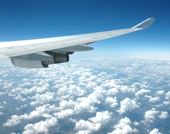 |
The UK government said a third runway could be built at Heathrow without breaching strict environmental limits, as it launched a consultation on the expansion of the congested London airport.
The government will now seek opinions from the public and other interested parties over whether an extra runway served by a sixth terminal could be built while still meeting local noise and air quality limits.
A new runway is essential to boost the capacity of Heathrow, but its development is likely to be met with fierce opposition from local residents and environmental campaigners.
Although a fifth terminal will open next March at Heathrow, it won't increase the number of takeoffs and landings that can be handled each day. The airport's existing two runways are now operating at about 99 percent of their allowed capacity of 480,000 airplane movements each year.
A third runway would mean Heathrow could be able to handle some 700,000 flights each year . This would allow the two existing runways to handle both takeoffs and landings. Currently, one runway is used for takeoffs at any one time and one is used for landings
Officials at Heathrow owner BAA have said that a third runway could be built by 2015 in a best-case scenario, but most observers see 2020 as a more realistic date. The consultation period, which ends next February, is likely to be followed by a lengthy public inquiry and planning process.
Heathrow's expansion is crucial for the long-term growth of carriers operating there, such as British Airways and Virgin Atlantic Airways. The airlines and BAA, a unit of Grupo Ferrovial, are concerned that Heathrow will lose long-haul transfer traffic to less congested airports on the European continent. BA is by far the largest user at Heathrow and will move over to terminal five next year.
Airline bosses and business leaders have argued that failing to build a third runway would damage the local and wider UK economy.
Environmental campaigners contend that expanding Heathrow goes against the government's policy of reducing carbon dioxide emissions.
It's estimated that building the new runway could cost more than $10.4 billion, according to BAA CEO Stephen Nelson. He said some 700 homes are at risk from the development plans.
BAA's development proposals are based on constructing a shorter 2,200 m long runway, but this may not be able to handle takeoffs from fully laden wide-bodied jets like the Airbus A380 and the Boeing 747.
CargonewsAsia
|













